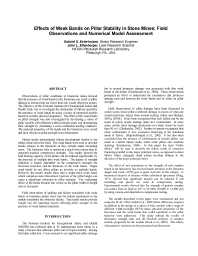Mining Publication: Effects of Weak Bands on Pillar Stability in Stone Mines: Field Observations and Numerical Model Assessment
Original creation date: July 2007
Observations of pillar conditions in limestone mines showed that the presence of weak bands in the limestone can result in pillar damage at stresses that are lower than one would otherwise expect. The objective of this National Institute for Occupational Safety and Health study was to investigate the mechanism of failure caused by the presence of weak bands by using a series of numerical models based on realistic physical properties. The effect of the weak bands on pillar strength was also investigated by developing a series of pillar models with different width-to-height ratios and determining their strength by simulating a servo-controlled loading condition. The material properties of the bands and the limestone were varied and their effects on pillar strength were determined. Model results demonstrated failure development similar to the pillars observed in the field. The weak bands were seen to develop tensile stresses in the limestone as they extrude under increasing stress. The limestone fails in tension at a much lower stress than its expected uniaxial compressive strength. The results showed the load bearing capacity of the pillars can be reduced significantly by the presence of multiple thin weak bands. The degree of strength reduction is largely dependent on the compressive strength, the frictional resistance and the thickness of the weak bands. Single weak bands do not affect pillars as severely as multiple bands. However, the model results show that a single thick weak band, which comprises more than about 2 percent of the pillar height, can cause a significant reduction in pillar strength. The weakening effect of the bands become less severe as the pillar width-to-height ratio is increased. Field observation of spalling and failure associated with weak bands in limestone pillars show that the failure mechanism in the models resembles the observed failure. The model results provide insight into the important factors affecting pillar strength in the presence of weak banded materials.
Authors: GS Esterhuizen, JL Ellenberger
Conference Paper - July 2007
NIOSHTIC2 Number: 20032439
Proceedings of the 26th International Conference on Ground Control in Mining, July 31 - August 2, 2007, Morgantown, West Virginia. Peng SS, Mark C, Finfinger GL, Tadolini SC, Khair AW, Heasley KA, Luo Y, eds., Morgantown, WV: West Virginia University, 2007, Jul; :320–326
See Also
- Analysis of Pillar Design Practices and Techniques for U.S. Limestone Mines
- Coal Bumps and Odd Dynamic Phenomena - A Numerical Investigation
- Evaluation of the Effects of Length on Strength of Slender Pillars in Limestone Mines Using Numerical Modeling
- Field Observations and Numerical Studies of Horizontal Stress Effects on Roof Stability in U.S. Limestone Mines
- In Situ Stress Measurements Near the Ross Shaft Pillar, Homestake Mine, South Dakota
- Investigation of Pillar-Roof Contact Failure in Northern Appalachian Stone Mine Workings
- Pillar Design Issues for Underground Stone Mines
- Pillar Stability Issues Based on a Survey of Pillar Performance in Underground Limestone Mines
- Pillar Strength and Design Methodology for Stone Mines
- Proceedings: New Technology for Ground Control in Multiple-seam Mining
- Page last reviewed: 9/20/2012
- Page last updated: 9/20/2012
- Content source: National Institute for Occupational Safety and Health, Mining Program


 ShareCompartir
ShareCompartir
